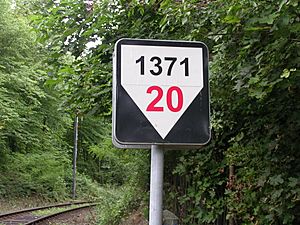Per mille facts for kids
A per mille (pronounced "per mill") is a special way to talk about small parts of a whole. It means "parts per thousand." Think of it like a percent sign (%), but instead of meaning "parts per hundred," it means "parts per thousand."
It is written as ‰. This symbol looks a lot like the percent sign, but it has an extra zero at the bottom.

Contents
Understanding Per Mille
The per mille symbol helps us show very small amounts in a clear way. Just as "percent" means "out of 100," "per mille" means "out of 1,000."
How Per Mille Works
If something is "10 per mille," it means 10 parts out of every 1,000 parts.
- For example, if a road has a slope of 50‰, it means that for every 1,000 meters you travel horizontally, the road goes up or down by 50 meters.
- This is the same as saying 5 parts out of every 100, or 5%. So, 50‰ is equal to 5%.
Per Mille vs. Percent
It's easy to change per mille into a percentage.
- To go from per mille to percent, you divide the per mille value by 10.
- For example, 20‰ (20 per mille) is the same as 20 divided by 10, which is 2%. So, 20‰ = 2%.
- To go from percent to per mille, you multiply the percentage by 10.
- For example, 3% is the same as 3 multiplied by 10, which is 30‰. So, 3% = 30‰.
Where is Per Mille Used?
You might see per mille used in a few places:
- Slopes and Gradients: As seen in the images, per mille is often used to describe how steep a road, railway, or tram track is. It tells you the change in height over a certain horizontal distance.
- Blood Alcohol Content: In some countries, per mille is used to measure the amount of alcohol in a person's blood. (However, this is a topic usually discussed in more advanced contexts.)
- Salinity of Water: Sometimes, the saltiness (salinity) of water, like in oceans, is measured in per mille. This shows how many grams of salt are in 1,000 grams of water.
Images for kids
-
A tram and gradient sign in Gdańsk, Poland. The 50‰ grade is equivalent to 5%.
See also
 In Spanish: Por mil para niños
In Spanish: Por mil para niños


